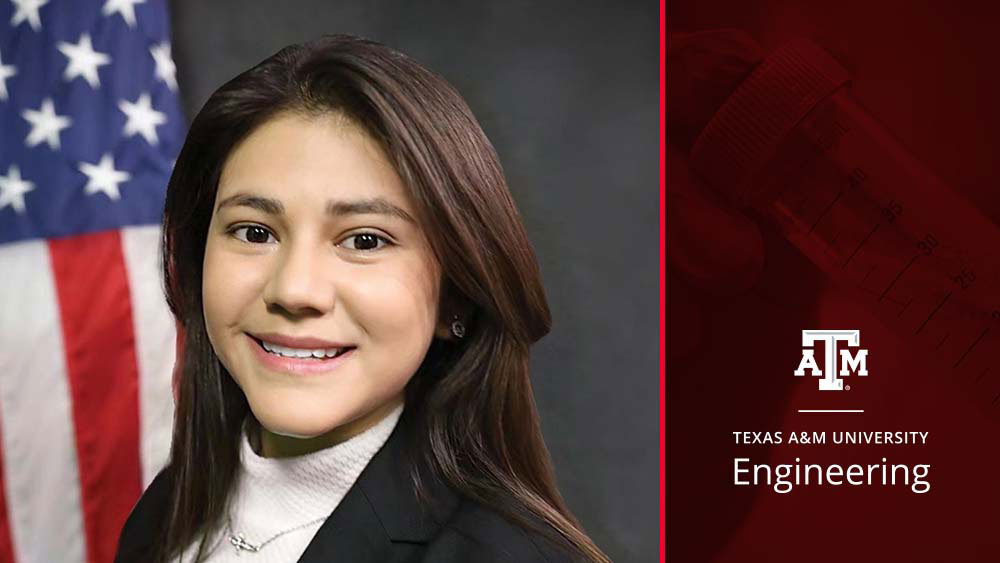
Jessica Zamarripa ’20 has received two prestigious fellowships to help further her doctoral studies. |
Image: Texas A&M Engineering Communications
Jessica Zamarripa ‘20, a graduate student in the Department of Materials Science and Engineering at Texas A&M University, has received two prestigious awards, the 2022 National Defense Science and Engineering Graduate (NDSEG) Fellowship and the National GEM Consortium Ph.D. Engineering and Science Fellowship.
Zamarripa, a master’s student, received her bachelor’s degree in electrical engineering from Texas A&M University.
Her current research focuses on the development of a multiphysics topology optimization tool used to evaluate and analyze alternating current circuit designs for the deployment of novel electronics and flexible circuits created from liquid metal-based inks. She collaborates weekly with the researchers at the Air Force Research Laboratory and has also spent summers on site at the Wright-Patterson Air Force Base.
The Department of Defense NDSEG Fellowship is awarded annually to students in recognition of their academic excellence and STEM (science, technology, engineering and math) achievements. Awardees receive full tuition and coverage for all mandatory fees for up to three years at any accredited U.S. college or university that provides advanced degrees in science and engineering, as well as a monthly stipend of $3,400.
The National GEM Consortium is a distinguished external fellowship that connects leading corporations, laboratories, universities and research institutions to support and enable qualified students from underrepresented communities to pursue graduate education in applied science and engineering. As part of her GEM fellowship, Zamarripa was selected by NASA headquarters to become a GEM Employer Fellow. Fellows are provided a paid graduate-level summer work experience for at least one summer.
Zamarripa will utilize both fellowships next year as she begins her doctorate under the guidance of Dr. Darren Hartl, associate professor in the Department of Aerospace Engineering, with a courtesy appointment in the Department of Materials Science and Engineering. Hartl is also the director of the M2AESTRO Laboratory.
“Jessica is one of the hardest-working students I know,” said Hartl. "She is a testament to the potential of all first-generation engineering students who surround themselves with a strong team as they face academic and research challenges head on.”
Zamarripa, a master’s student, received her bachelor’s degree in electrical engineering from Texas A&M University.
Her current research focuses on the development of a multiphysics topology optimization tool used to evaluate and analyze alternating current circuit designs for the deployment of novel electronics and flexible circuits created from liquid metal-based inks. She collaborates weekly with the researchers at the Air Force Research Laboratory and has also spent summers on site at the Wright-Patterson Air Force Base.
The Department of Defense NDSEG Fellowship is awarded annually to students in recognition of their academic excellence and STEM (science, technology, engineering and math) achievements. Awardees receive full tuition and coverage for all mandatory fees for up to three years at any accredited U.S. college or university that provides advanced degrees in science and engineering, as well as a monthly stipend of $3,400.
The National GEM Consortium is a distinguished external fellowship that connects leading corporations, laboratories, universities and research institutions to support and enable qualified students from underrepresented communities to pursue graduate education in applied science and engineering. As part of her GEM fellowship, Zamarripa was selected by NASA headquarters to become a GEM Employer Fellow. Fellows are provided a paid graduate-level summer work experience for at least one summer.
Zamarripa will utilize both fellowships next year as she begins her doctorate under the guidance of Dr. Darren Hartl, associate professor in the Department of Aerospace Engineering, with a courtesy appointment in the Department of Materials Science and Engineering. Hartl is also the director of the M2AESTRO Laboratory.
“Jessica is one of the hardest-working students I know,” said Hartl. "She is a testament to the potential of all first-generation engineering students who surround themselves with a strong team as they face academic and research challenges head on.”